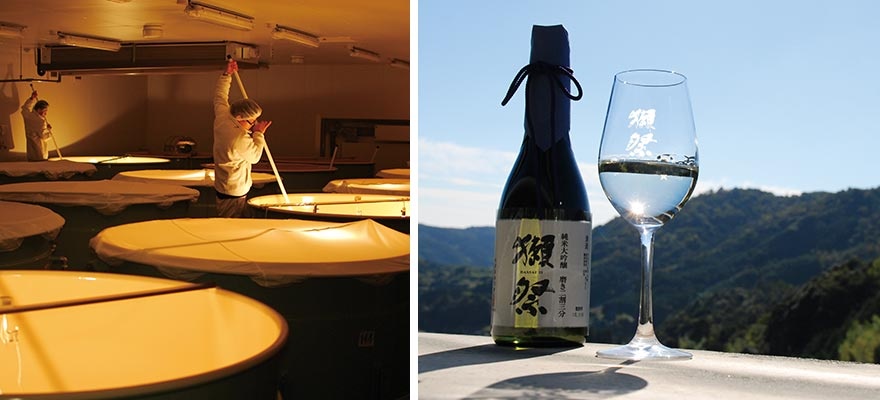Local Brewer Reinvented with Global Sake
25 years ago, Asahishuzo was just a local brewer with a faltering brand, its products losing market share not only to other breweries but also to beer, wine, shochu and other beverages. "Many sake brewers, including ourselves, didn't prioritize quality," explains Kazuhiro Sakurai, the company's executive vice president, "and as a result, sake became a minor player in the alcoholic beverage market."
Hard times required drastic measures, and President Hiroshi Sakurai reinvented his company. He did away with its unremarkable flagship product, Asahi Fuji, and focused exclusively on premium junmai ginjo and junmai daiginjo pure-rice sake.
Brewed through a characteristic Japanese formula, sake is predominantly composed of rice, koji mold spores and water. Top-tier sake is distinguished primarily by the degree to which its rice grains have been milled prior to brewing. Milling removes unwanted fat and protein from the outer part of the grain, leaving a higher percentage of starch for fermentation, which leads to improved flavor. While at least 40 percent of the rice grain must be milled off for junmai ginjo sake, and more than 50 percent must be milled off to achieve first-class junmai daiginjo certification, Asahishuzo mills away up to 77 percent of the rice grain—recognized as being close to the highest degree of milling for any sake in the world. In fact, the product names of Dassai 50, 45, 39 and 23 indicate the percentage of the grain remaining after milling.
As it reinvented itself, Asahishuzo made a point of listening to its customers' voices, enhancing the products that were well-received and cutting those that weren't. "Actually, we were lucky that our brand was weak in the local market," Vice President Kazuhiro Sakurai says. "If we'd had a strong local brand, our existing local-area and Yamaguchi Prefecture markets would have made it difficult to adjust the taste of our product."
At the same time, Asahishuzo began a process of modernization. It brought in centrifuges to process its top-end 23 and 39 sake, while installing refrigerated rooms gave the company a crucial advantage. Traditional sake requires a slow fermentation process that's only achievable in the low temperatures of the colder months. But refrigeration allowed the company to brew year-round.
Traditional techniques still remain, of course. During the fermentation process, Asahishuzo still utilizes the natural heat from fermenting rice in lieu of external heating equipment. And while it would be cheaper to have machines stir the steamed rice used to make the koji sake starter mold, this is still done by hand because machines might disintegrate the delicate rice grains. "We do all we can to protect the taste," Kazuhiro Sakurai says.
Despite such efforts, success didn't come easily. Yamaguchi isn't particularly renowned as a sake-brewing region, and buyers in Osaka to the east and Kyushu to the south both spurned the company's products. As a result, President Hiroshi Sakurai decided to leapfrog the local market and concentrate on building market share in Tokyo, even going door-to-door to sell his sake.
The strategy worked, and growing popularity in Tokyo had the knock-on effect of generating demand in Osaka and Kyushu—and even on the company's home turf in Yamaguchi. Dassai's brand is now so highly regarded that it's even served at major diplomatic events.
Kazuhiro Sakurai estimates that sake comprises only about 6 percent of the Japanese alcoholic beverage market, but combined with burgeoning interest in Japanese food overseas, there's much room for growth worldwide.




